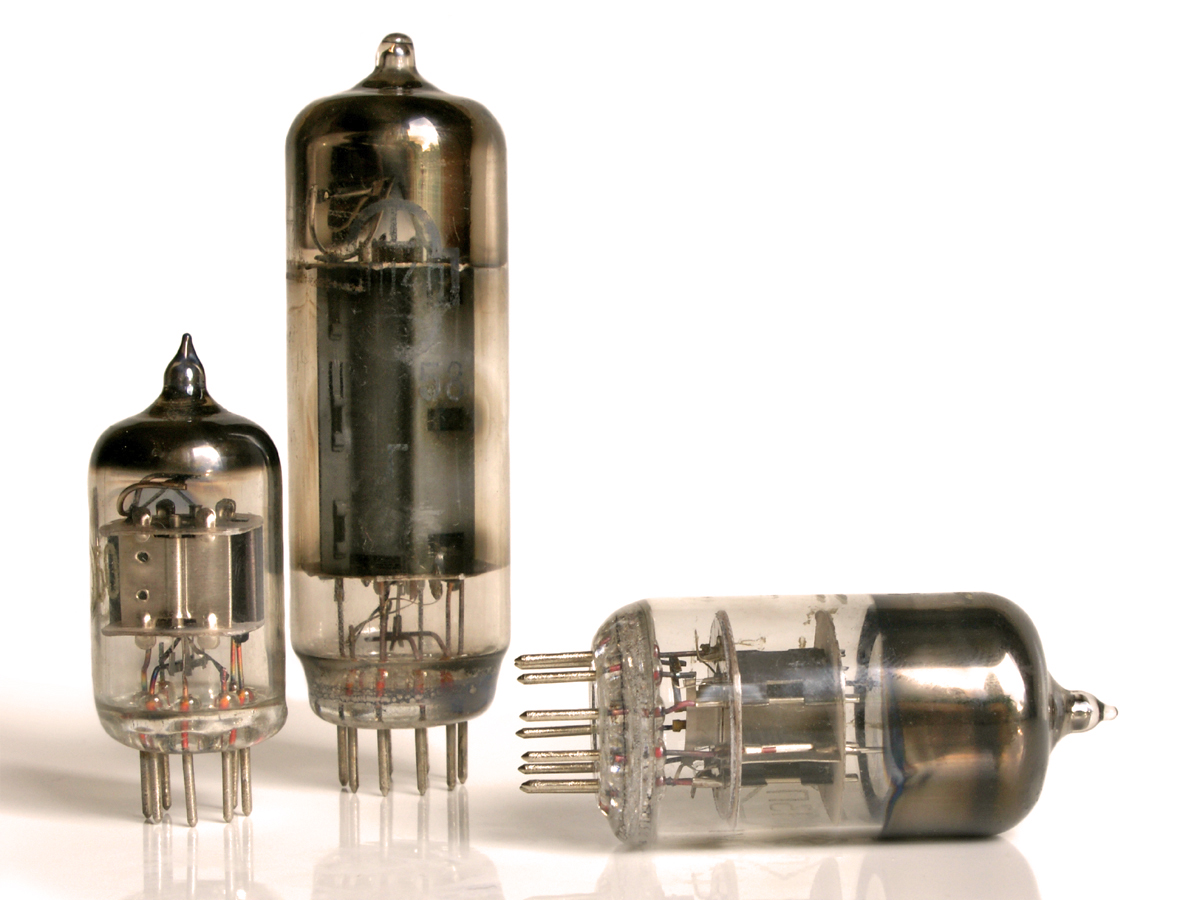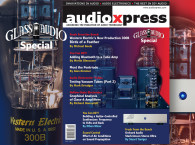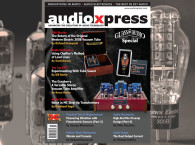Since the “tetrode kink” was produced by secondary emission, the “Harries Valve” eliminated the kink. By this time, the power pentode had been invented and patented by Philips, a Holland-based company. With a higher voltage gain than power triodes, the pentodes were quickly adopted.
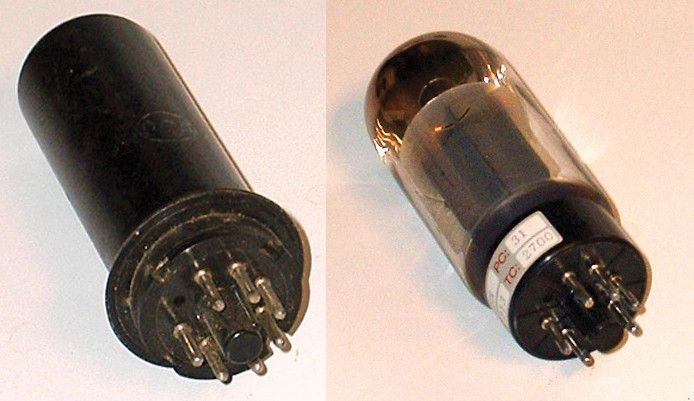
Beam Power Tubes
In 1936, RCA developed the 6L6 beam power tube shown in Photo 1, in which Harries’s innovation was accompanied by replacing the suppressor grid with “beam-forming plates.” This design worked well, and since the 6L6 is a “beam power tetrode,” it evaded the Philips patent on power pentodes. The 6L6 is an octal-base tube, and the original version had a metal envelope.
The 6L6G, the 6L6GA, the 6L6GB, the 5881, the 5932, the 7027, and the 6L6GC shown in Photo 2 were later developed. Their glass envelopes enhanced radiation cooling of the plate and permitted higher maximum plate dissipation ratings. The original 6L6 had a maximum plate dissipation of 19 W, whereas the 6L6GC is rated at 30 W. There is also a tube numbered 6L6WGB, which is electrically identical to the 6L6GC, but is ruggedized for military or airborne use. (The “A,” “B,” and “C” are revisions, so strictly speaking, the “WGB” is a ruggedized 6L6GB, which may not handle as much plate voltage as a 6L6GC. The tube manual specifications are not consistent.)
Other popular beam power tubes include the 6V6, the 6550, the 6BQ5/EL84, the KT66, the KT88, and the KT90. The 6V6 is a lower-voltage, lower-power (350-V, 14-W) beam power tube (see Photo 3). It was designed in 1937 and used mostly in single-ended output stages of radio and TV sets. The 6V6s have also been used in push-pull configurations for Hammond organ power amplifiers and guitar amplifiers. Two 6V6s in push-pull can output about 14 W.
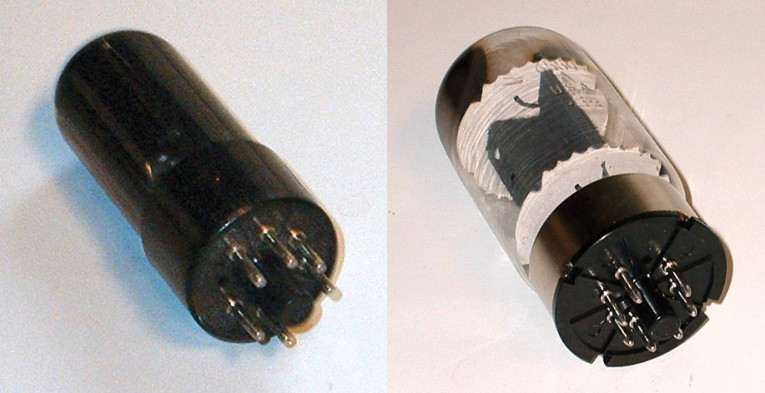
The KT66 tetrode is the European version of the 6L6GC. The 6550 shown in Photo 4 is a higher-voltage, higher power tube similar to a 6L6GC. It is rated at 600 V with a 35-W plate dissipation. The 6L6GC is rated at 500 V with a 30-W plate dissipation. Its European counterpart is the KT88, which is almost identical, but is rated at 40-W plate dissipation. The KT90 is another similar tube, with a 50-W rating.
The 5881 was advertised some years ago as a “ruggedized 6L6GC” (see Photo 5). But with ratings of 400-V maximum plate voltage and 23-W maximum plate dissipation, it should not be used to replace a 6L6GC. The 7027 shown in Photo 6 performs similarly to the 6550. It has the same maximum plate voltage and power ratings. It was used in some Ampeg guitar amplifiers and in some Altec-Lansing commercial audio amplifiers.


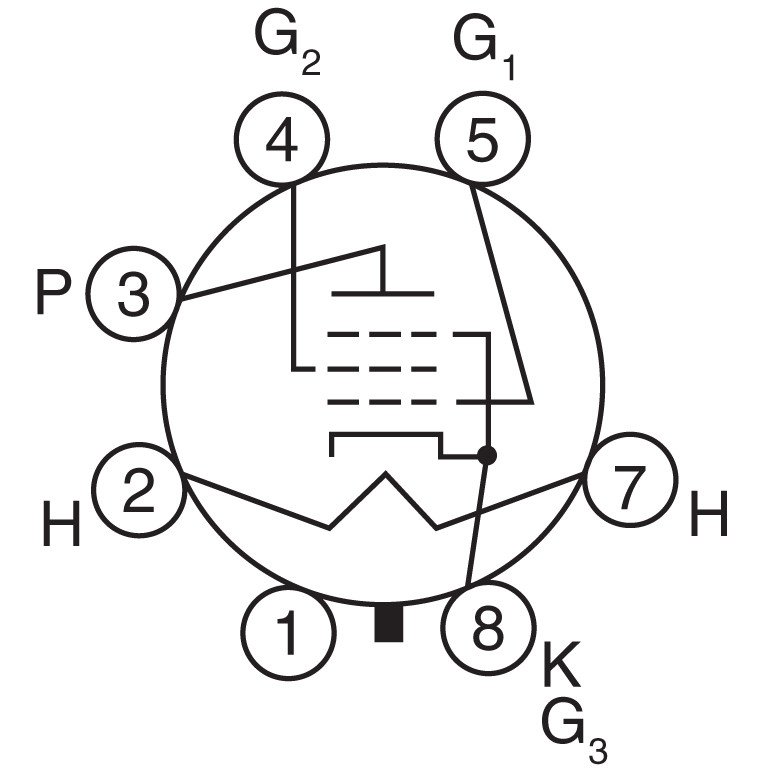
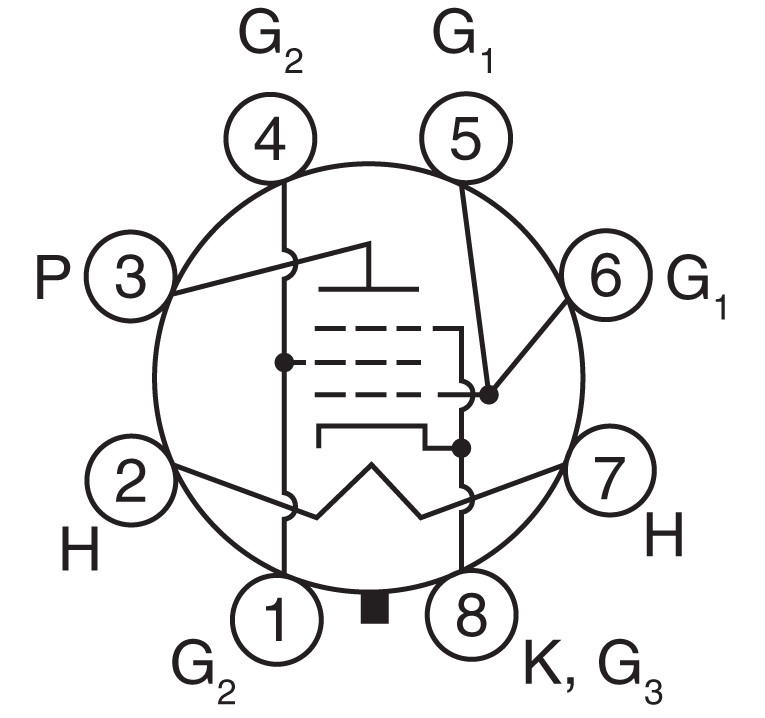
The 6L6GC, the 6V6, the 6550, and the 5881 all have octal bases and use the “7AC” basing configuration shown in Figure 1. The 7027 is also an octal base tube, but it uses the “8HY” base. Figure 2 shows that the screen grid is brought out to pins 1 and 4. The control grid is brought out to pins 5 and 6 can make the 7027 unworkable as a plug-in replacement for the 6L6GC or its “7AC” cousins. It all depends on whether the original amplifier builder used pins 1 and 6—which are not connected to anything in the 7AC-base tubes — for convenient tie points in the circuit. If they are used as tie points, it is unlikely that these points should be connected to the screen and control grids, respectively. Plugging in a 7027 might let the smoke out of the components.
The remaining popular beam power tube, shown in Photo 7, is the 6BQ5/ EL84, which has a miniature nine-pin base. With a 300-V maximum plate voltage and 12-W maximum plate dissipation, it is a bit less powerful than a 6V6, but it has been used in similar
circuits.
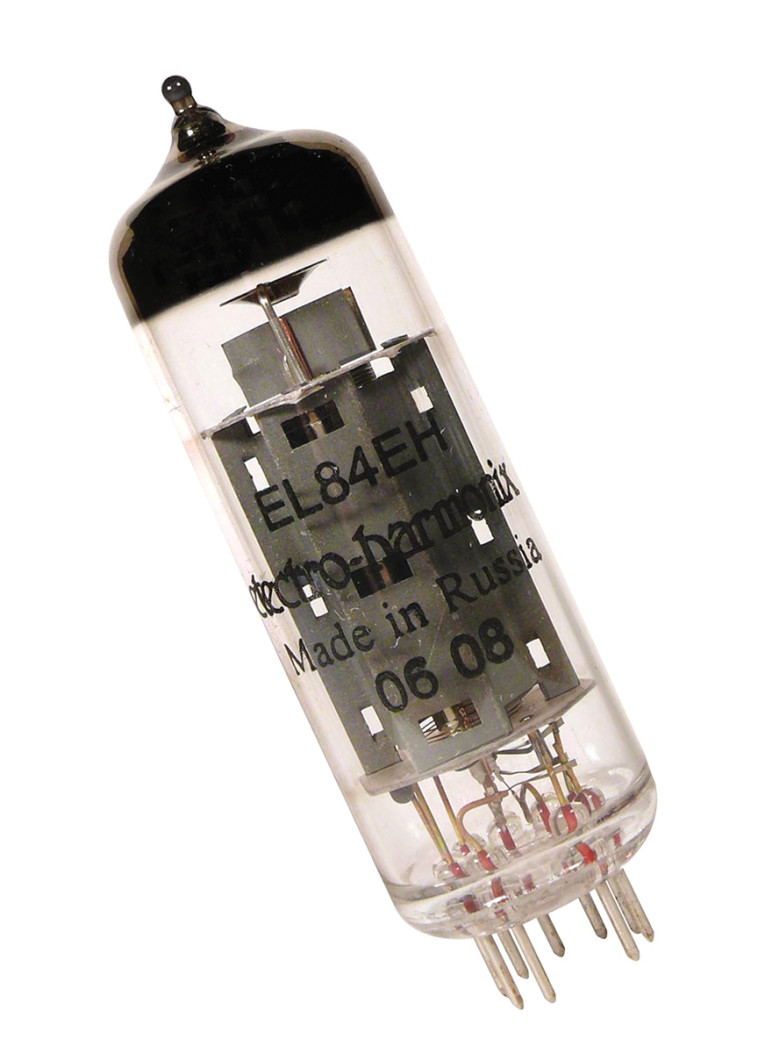
Another immigrant from the RF beam power tube camp is the 807. Rated similarly to the 6146B (600-V maximum on plate, 25 W plate dissipation), the 807 also uses a plate cap connection, but it has a five-pin base rather than the 6146’s octal base. In the past, the 807 was often used in commercial audio amplifiers.


True Power Pentodes
By far most of the audio power amplifier tubes used today (in fact, since 1940) are power pentodes or beam power tubes. The EL34, the 6CL6, the 6F6, the 6G6, and the 6K6GT are some examples of true power pentodes. Some musicians prefer power pentodes as output tubes in electric guitar amplifiers because of their higher distortion characteristics, which are partially the result of higher transconductance, which leads to higher gain in the amplifier circuit. For example, a 6L6GC operating with 250 V on the plate has 4,700-microsiemens (μS) transconductance, compared to 11,000 μS for an EL34 power pentode under similar conditions.
Since voltage gain is directly proportional to transconductance, the EL34 would have about 2.34 times the gain of a 6L6GC in the same circuit. The EL34 (the KT77) power pentode was introduced by Mullard in 1953 — unlike the 6L6, the EL34 has its suppressor grid connection brought out to a separate pin (pin 1) as shown Figure 3. Its heater draws 1.5 A compared to 0.9 A in the 6L6. However, Sylvania (and possibly GE) marketed a tube similar to the EL34 as a 6CA7, which not only was packaged in a markedly different “fat boy” envelope, but used a beamforming plate much like a 6L6. Although the 6CA7 and the EL34 tubes have similar (but not identical) characteristics, they are made very differently. Both are widely used in high-end guitar amplifiers because they are characterized by greater distortion at lower power than the 6L6, the 6550, and the KT66. The EL34 is found in many British guitar amps (e.g., Marshall and Hiwatt) and is associated with the “British Tone.” The 6L6 is generally associated with the “American Tone,” exemplified by Fender and Mesa Boogie amps.
The 7591 and the 7868 are almost identical power pentodes in that they have 550-V maximum plate voltages and 19-W plate dissipation limits. Thus, they can produce about 40 W when used in a push-pull pair. The difference between these tubes is the base style. The 7591 uses an 8KQ octal base (see Figure 4). In contrast, the 7868 has a 9RW Novar base. An Internet search will reveal that these tubes have become the target of inquiry by musicians/hobbyists in search of a “new, different” sound.
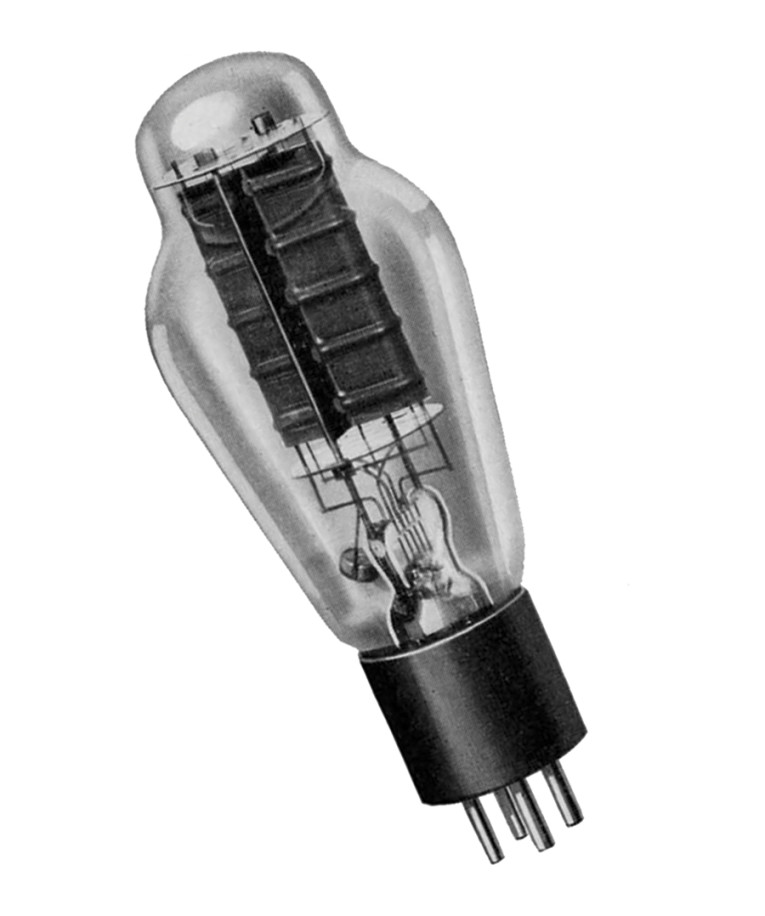
Single-Ended Power Triodes
Many fanciers of hollow-state audio equipment prefer single-ended (not rather than power pentode- or beam power tube-based ones. Their preference is due to the power triodes’ particular distortion signature, as discussed in previous articles. True purists prefer to use the Western Electric 300A or 300B power triodes shown in Photo 8, in spite of their astronomical price (ranging from upward of $100 each for modern copies to almost $1,000 each for genuine Western Electric tubes). The 300B is rated at 400-V maximum plate voltage and 36-W maximum power dissipation.
With 350 V on the plate, and a 74-V control-grid bias, the 300B has an amplification factor (μ or mu) of 3.9. One 300B used in a Class-A amplifier can produce approximately 7-W output. A somewhat more recent, lower cost alternative to the 300B is the 2A3 power triode (see Photo 9). It is a lower-power tube rated at 300-V maximum on the plate and 15-W maximum power dissipation. With 250 V on the plate, and a –45-V control-grid bias 2A3 has an mu of 4.2. In a Class A circuit, it can output about 3.5 W.
Another alternative for power triode performance is to use a power pentode or beam power tube with the screen grid strapped to the plate and the suppressor grid or beam-forming plates strapped to the cathode (this latter strapping is done internally in some tubes, such as the 6L6 family). A triode-connected 6L6GC will handle a maximum plate voltage of 500 V, and has a power dissipation of 30 W. With 450 V on the plate and a –20-V control-grid bias, the mu is 8.
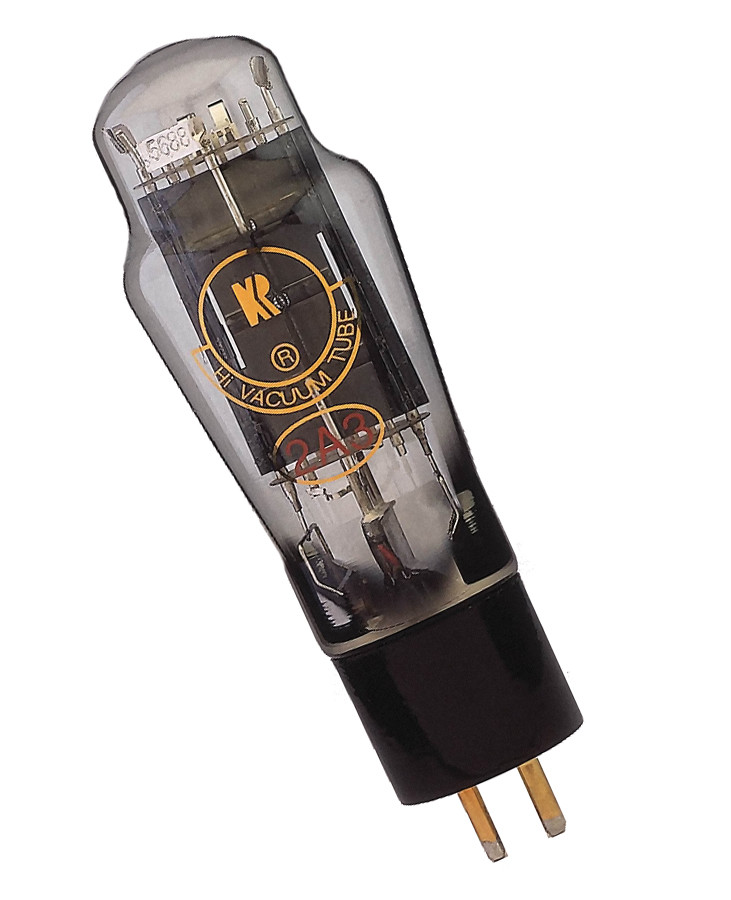
In a traditional single-ended Class A triode power amplifier, both the DC and the AC component of the plate current flow through the output transformer’s primary winding. This can cause core saturation of the transformer, with a lot of resulting distortion. Inserting a gap in the transformer core prevents core saturation; however, the gap decreases primary inductance and limits bass response.
To avoid the reduction in bass response, a larger output transformer (more windings than would be needed without a gapped core) can be used to increase the inductance. An alternative circuit called the “parafeed amplifier” feeds the plate from the B+ supply through a high-inductance choke. A coupling capacitor then blocks the DC component from passing through the output transformer, preventing saturation. aX
This article was originally published in audioXpress, May 2013 as part of the Hollow-State Electronics monthly column by Richard Honeycutt.



